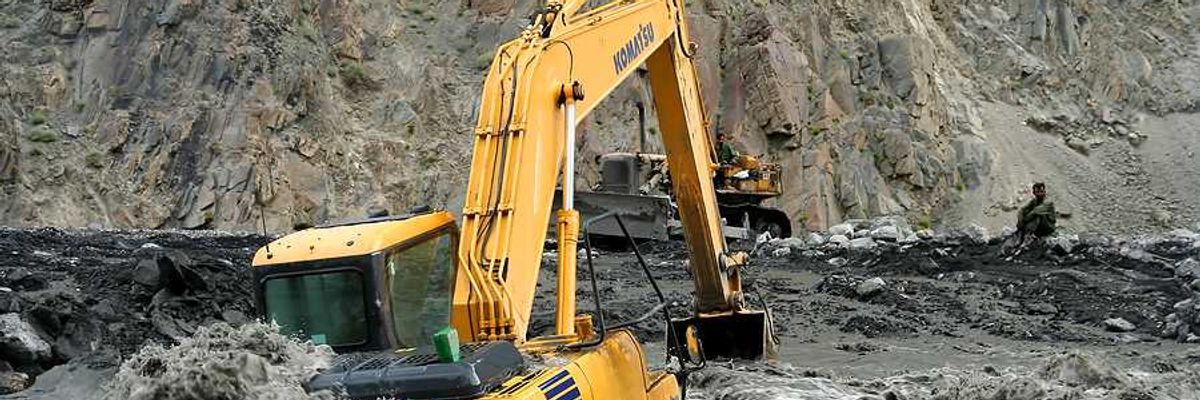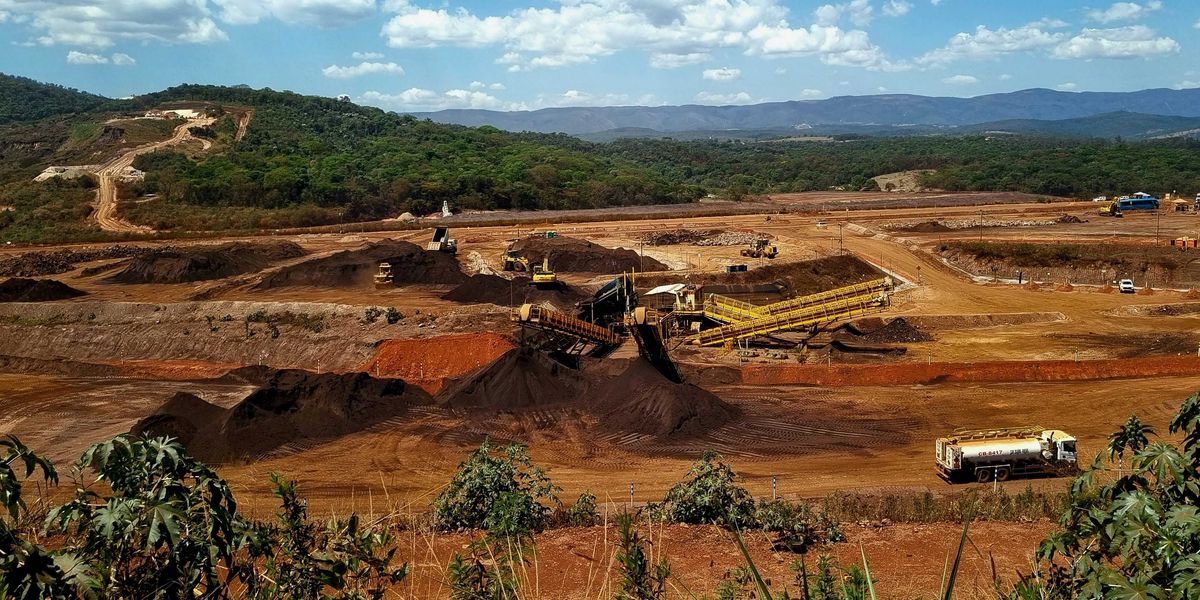population_trends
New Earth surveillance tech is about to change everything, including us
New high-resolution satellites, AIs, and data tools are going to let us study Earth, and ourselves, in greater detail than ever before.
Puerto Rico’s troubles are far from over. The population’s health is at risk
Analysis: Why we must talk about population.
Reading David Roberts’ recent explanation of why he never writes on overpopulation, I felt compelled to reply.
36
3
13
A Response to David Roberts’ Self-Censorship on Overpopulation
Reading David Roberts’ recent explanation of why he never writes on overpopulation, I felt compelled to reply. While Roberts made a set of superficially convincing arguments, ultimately he’s wrong not to focus directly on the population pressures we’re facing. Not confronting population head-on is like looking out the window of a plane and realizing you’re about to crash but refusing to tell the other passengers about the impending crash. Instead you spend your remaining moments convincing people that it’s “empowering” to wear their seat belts. That it’s a good for their health to put their laptops away and hold their head between their legs. Sure, you’ll convince some—and those you do convince might be better off—but you’ll convince far fewer as the sense of urgency is gone.
Reducing the global population is essential in addressing humanity’s impact on the planet—along with reducing overall consumption (affluence) and the use of unsustainable technologies (all variables in the I = PAT equation). And after the missteps of the Sierra Club and some governments, Roberts can be excused for why he feels it may be smarter to simply address the P in the equation indirectly by focusing on women empowerment and providing good access to family planning (and I would add providing comprehensive sexuality education to all children, as Mona Kaidbey and Robert Engelman and discuss in EarthEd: Rethinking Education on a Changing Planet). But that won’t be enough.
Stabilizing population is urgent. The goal should not simply be to nudge along a little less growth so population stabilizes at 9 billion rather than 9.5 or 10 billion. Instead, we need to make a long term plan to get population back to a manageable range. How far to scale population back, as noted 10 years ago by Roberts in another essay on why he doesn’t talk about population, “is up for debate, but probably a lot.” Some, including Paul Ehrlich, have suggested the ideal population range is around 1-3 billion, depending on how badly we have damaged the Earth’s systems and how much we want to consume moving forward. If Roberts is serious when he says he wants poor countries to be less poor “than their forebearers” then that means the Affluence variable in the I = PAT equation will increase. Yes, affluence elsewhere must shrink in accordance (and I wholeheartedly agree that wealth inequities need to be grappled with as does consumerism more broadly), but our population—particularly the 2-3 billion of us in the global consumer class—is completely overwhelming Earth’s systems.
One-Planet Living
In Is Sustainability Still Possible?, Jennie Moore and William Rees explored what a one-planet lifestyle would look like (in a world with 7 billion not 9.5 billion) and their analysis shows that if we lived within Earth’s limits, gone would be the days of driving personal vehicles, flying, eating meat, living in large homes, and essentially the entire consumer society that we know today. Frankly, that’s fine with me, considering the ecological, social and health costs of modern society—but most will not accept that. And considering that—and that policymakers and economists and even most environmentalists still believe further economic growth is possible and even beneficial—it’s increasingly hard to imagine any scenario other than a horrifying ecological collapse in our future.
That is another reason why we should prioritize population degrowth. Every million people not born is a million not to die when climate change brings about terrible flooding, droughts, disasters and famines it will in the increasingly near future. And please don’t take this to the absurd extreme that, ‘well, let’s just stop reproducing altogether and then there’ll be no suffering.’ I’m not saying people should have no children at all (here’s another Tucker Carlson video for you to enjoy, this one with the founder of the Voluntary Human Extinction Movement). But people should have far fewer—particularly in overdeveloped countries like the United States. I personally chose to have one child, even though both my wife and I would like to have a second. But I deemed it morally irresponsible, or in the words of bioethicist Travis Rieder probably not ‘honorable’ to have a second, particularly knowing what’s in store for our kids in the coming century, and knowing that by living in the United States, I am a ravenous consumer no matter how hard I try to be otherwise.
Historical Efforts
Roberts also selectively focuses on history to better make his point—providing examples of the Sierra Club brouhaha but not the work of all the population organizations that helped shift population trends in a positive direction. And while there have certainly been tragic missteps—such as India’s efforts at forced sterilization—there have been unqualified successes. In his book Countdown, Alan Weissman describes the amazing case study of Iran, which through a focused campaign, reduced population growth dramatically. Yes, the primary tactics were to provide free family planning and education, which I don’t think anyone will disagree are very smart tactics, but the government was clear in its goal and the urgency—and also supplemented its efforts with social marketing to create a smaller “normal” family size, including advertisements on TV, banners, and billboards that “One is good. Two is enough.” Similar successes can be seen in the efforts of the Population Media Center that uses soap operas to shift norms around population size.
While I don’t know if the numbers were or could ever be estimated, efforts like Iran’s and PMC’s, like Stephanie Mills committing so publicly to never have children at the height of her reproductive years, and Paul Ehrlich capturing the public’s attention with his warnings about the population bomb, all of this helped focus our collective attention on population issues in the 1960’s and 70’s and helped slow population growth.
Ultimately, Ehrlich, with as much criticism as he receives, was not wrong about the population bomb. His warnings and the efforts they helped trigger—along with the Green Revolution—allowed us to extend the fuse. But in all those years, the fissile material has also been building, and when the bomb finally explodes, the shockwaves will be felt around the world. In fact, even Norman Borlaug, the father of the Green Revolution warned, “Unless progress with agricultural yields remains very strong,” which Borlaug noted cannot continue indefinitely unless we cut down our forests, which he implored us not to do, “the next century will experience sheer human misery that, on a numerical scale, will exceed the worst of everything that has come before.”
Immigration
As for immigrants—sure it probably wasn’t the best idea for Professor Phil Cafaro to go on Tucker Carlson’s show to support anti-immigrant sentiments, but Cafaro’s point is valid, even if uncomfortable and confusing for progressives. Until America has a one-planet footprint, all new immigrants are going to increase global impacts because they’ll consume more in the US than in their home countries. (This even suggests all adoption ideally should be domestic, which is a-whole-nother can of worms!)
That’s not to say we should ban immigration or foreign adoption, but it means we should have a clear plan around immigration (along with one on reducing American consumption) and we should offset immigration by reductions in births of Americans (easier done if we have a population goal in mind for the United States). This offset is essentially what’s happening in European countries that have smaller than replacement rate birthrates—but the problem there is that this cultivates anti-immigrant sentiments as white European populations suddenly darken. With America at least, we have always been an immigrant nation so theoretically we could adapt, though obviously the current administration and its supporters are fomenting the same fears and biases that Americans have shown since its early days, as waves of immigrants from Ireland, Southern Europe, China, and Mexico started arriving.
Setting Goals
Is it so scary or morally fraught to start advocating for a smaller global population—or at the very least start talking openly about population challenges? Is it impossible to imagine nurturing a one-child family size norm in the US and Europe (where each child’s impact is many times greater than a child’s in a developing country)? One is good. Two is enough. Three is too many.
As Roberts notes, momentum is already bringing us toward smaller family sizes—but that same momentum is also bringing us toward higher consumption rates. Some smart social marketing and celebrity modeling could bring us toward population reductions quicker. Breaking the myth that sole children are spoiled and lonely—as Bill McKibben did in his great book Maybe One—would be a good place to start. As would showing the economic and environmental benefits of having one child. And so would making it cool to have one child. Perhaps that’s the marketing slogan we use: “It’s Hip to Have One.”
And let developing countries shape their own population targets so as to avoid the obvious criticisms of imperialism (maybe it’s even time for a Framework Convention on Population Growth to go along with the Framework Convention on Climate Change—so all countries can feel ownership in this effort). But clearly, population stabilization is as important in developing countries—not because of the immediate effects on human impact (I), but because as Earth systems finally break down after the decades of abuse we’ve delivered, people are going to retreat from their flooding towns, their drought stricken lands, their war-torn regions, and they’re going to have to go somewhere. And then the right-wing extremists will say “we told you so,” waving their copies of Camp of Saints in their hands as they do, and be perfectly poised to take over more government institutions—and that may be the population crisis’ scariest outcome of all.
Should we be having fewer children for the sake of the planet?
Supporters’ contributions to our podcast on population and climate change show exactly why we need to talk about this issue.
Supporters’ contributions to our podcast on population and climate change show exactly why we need to talk about this issue
Listen to the podcast here
Many readers ask why childless lifestyles are not more actively promoted by politicians and celebrated in societies.
Many readers ask why childless lifestyles are not more actively promoted by politicians and celebrated in societies. Photograph: Sergei Fadeichev/TASS
View more sharing options
Shares
147
Vicky Frost and Guardian supporters
@vickyfrost
Saturday 7 October 2017 07.41 EDT Last modified on Saturday 7 October 2017 08.08 EDT
Last month, on these pages, I asked if you might get in touch with your questions and thoughts on population and climate change. You did – in some numbers. These generous contributions form the heart of the latest edition of We Need to Talk About …, our podcast featuring supporters’ voices, in which your concerns are addressed by a panel of Guardian journalists and experts.
ADVERTISEMENT
As a starting point, we used a Guardian article with an arresting headline: Want to fight climate change? Have fewer children. In the podcast, we hear from one of the academics who produced the research which this article refers to, but equally interesting were your responses to this issue, and the discussions they prompted in our studio.
That’s why we’ve decided to publish some of them here. While we aim to hear from lots of voices and include differing points of view on the podcast, a lack of time means we sometimes have to cut people short, or use one person to represent the views of several who have contacted us making similar points. Here, we can give members a bit more space to air their views.
You can listen to the panel respond to them – our line-up is Damian Carrington, the Guardian’s environment editor; Lucy Lamble, the Guardian’s executive editor for global development, who often writes on and takes part in debates on global inequality; John Vidal, the multi-award winning former Guardian environment editor and Afua Hirsch, a writer and broadcaster for the Guardian and SkyNews among others, who has also worked in international development and the law.
But first gain a flavour of the concerns of your fellow readers below. Many of these questions appear in the podcast, while others influenced the direction in which we headed.
Poor allocation of resources is the problem – Kevin, Canada
Advertisement
The issue isn’t overpopulation – it’s poor resource allocation. We do not live in a world of lack, but of extreme waste and inefficiency. This is true of food, energy, land use and the financial system. The overpopulation argument is a way to once again deflect from real societal change that is needed, and instead focuses the discussion on families, usually poor families, having too many children.
While it is likely that the Earth does have some sort of maximum carrying capacity, even that is not guaranteed with recent technological advancements such as vertical farming. The question is whether those technological advancements will be put to use to raise the standard of living for every human being on the planet, or are put towards continuing to line the pockets of the wealthiest individuals and their investors.
We consume without asking where these things come from – Cristina, Brazil
To my mind, it is not the countries in Africa, or groups with a more traditional and much simpler way of life – such as Native people in North and South America, for instance – that have caused so many environmental problems, but the irrationality and consumerism of our western society. It is the fact that we consume without truly asking ourselves where all these goods come from, how they were produced, what the environmental impact is of producting all these mostly useless things. Unless we seriously address these questions, I cannot see any significant change or serious solution to climate change.
A convenient way to blame others – Marc, France
I‘ve often noticed that some westerners, who have no agenda at all on any environmental question, are keen to invoke “overpopulation” as the main and only threat to survival on Earth. Is overpopulation just a convenient way for westerners to put the blame on Africans for the environmental threats we face?
Entitlement to reproduce - Clare, UK
How can those with the largest carbon footprint be encouraged not to reproduce, when they are ones who make the greatest impact and have the greatest sense of entitlement?
Access to contraception faces a barrier: the church – Angela, UK
Advertisement
Pope Francis recently condemned climate change sceptics. He is passionate about protecting the planet and has called on everyone to care for creation, particularly as climate change disproportionately impacts the poor.
The Catholic church runs 25% of health and education systems worldwide and therefore, through its direct teaching and management, significantly reduces safe access to contraception for millions of women. No debate on controlling population growth and subsequent pollution can therefore exist without tackling this institutional barrier to action. Last year over 170 theologians issued a statement saying there was no reason for the Catholic church’s position against “artificial” contraception.
How does the panel feel the church can continue to do great work on this issue, yet continue to block safe access to contraception for some of the world’s poorest women?
Women are being denied choice about pregnancy – Sally, Hong Kong
I am a gynaecologist working in Hong Kong, occasionally counselling women considering having another child. If someone is ambivalent about doing so, I add into the decision-making the idea that having more children impacts climate change.
Since I was a teenager in the 1970s, I have believed it is a woman’s right to choose whether to continue a pregnancy. Working as a volunteer in an African country where abortion is illegal, I have seen women saved from death after trying to procure an abortion themselves. They were lucky – the hospital was nearby, there were good doctors, antibiotics, surgery, and blood transfusion.
2017: the year we lost control of world population surge?
Read more
In African countries where abortion is often illegal, an unmet need for contraception is also common. I applied for a volunteer job in northern Uganda where women having five to six children is the norm; when asked, they say they would have preferred three or four .
Donald Trump’s global gag rule which removes US aid from any NGO providing contraceptive advice, is a huge problem. Not only because maternal mortality due to abortion deaths will rise in Africa, but also because the UNFPA [UN population fund] will stop training midwives, and the resulting reduction in maternal mortality will diminish. In addition, there will be greater unmet need for contraception.
With good information couples will do the right thing – Dave, US
Do you think our society can reach the point where choosing to have fewer children as an essential carbon-cutting strategy is as widely understood as conserving energy?
As a parent I would take a bullet for either of my two children. I’m certain almost all parents would do just about anything to ensure their kids have a decent life. Knowing this, I cannot help but feel that if young couples around the world have good information they will do the right thing. If they understand the ramifications of their family-size decisions on the quality of life – chance of survival even – of their children, then they will make the most loving, compassionate decision possible: to conceive no more than one child.
We are failing to get the family-size issue across – Alison, UK
I joined Population Matters, an organisation that promotes smaller family size and reduced consumption, to find like-minded people and put my energies into a worthwhile organisation. I appreciate the impact we are having on the environment, and am mindful of that. However, I have found people around me such as family, friends and colleagues are largely not interested, or suggest they should have the freedom to do as they please.
How do we start making a difference? Also we seem to have failed with high-profile individuals, royals and celebrities in particular. So what happens now?
What will persuade people? Money? – Gwyneth, UK
We have to reduce the population, hopefully not by severe climate change, war or disease. China’s one-child solution would not be accepted by most people. What do experts suggest? It seems money has the only power over most people. Should we pay people not to have children?
Politicians don’t talk about this – Mike, UK
How do we get politicians to talk seriously about the links between population and climate change? The last three elections in the UK have barely mentioned the environment. Is there an agreement between the political parties to avoid this discussion?
Childless lifestyles need promoting – Michelle, UK
Advertisement
I like children, but have never felt that I would like to have my own.
I am very regularly treated as odd for this decision, and feel that if we don’t open up the discussion about not having children, people will never consider this decision thoroughly, whether for the environment or other reasons.
In the past three years, I have made a number of lifestyle changes in order to reduce my carbon footprint – which has only further cemented my feeling that I don’t want children. I often feel like I need to keep having what can be sometimes difficult conversations with people about this choice, so as to build conversation momentum around the subject. Alternative lifestyles need to be promoted. I would like to focus on supporting and improving the lives of people already on the planet.
Can we ditch our pro-reproduction stance? – Tet-Wo, New Zealand
I have made the decision to be childfree, largely due to environmental reasons. As a childfree person, I am constantly surprised how this decision is commonly questioned by others as being a poor or “selfish” choice when the evidence suggests that it is anything but.
Given the evidence that having fewer children isthe greatest decision one can make to combat climate change, do the panel think that society can switch from having a pro-reproduction stance, where policies promote reproduction and society views having children as the “correct” choice, to a neutral stance, where having children is considered optional and policies are made to promote other means of having a fulfilled life?
‘We don’t exist’: Life inside Mongolia’s swelling slums.
A scarcity of affordable housing has pushed thousands of low-income residents to the fringes of Ulan Bator, where they struggle for food and water.
ULAN BATOR, Mongolia — The land beneath Dolgor Dashnyam’s home is wet and gritty and smells of decay. Here, atop one of Ulan Bator’s largest landfills, Ms. Dashnyam lives under a roof made of soggy mattresses. She spends her days rummaging through piles of gin bottles and discarded animal bones, picking up pieces of scrap metal to sell in order to buy water and bread.
Ms. Dashnyam, 55, was once an ambitious college graduate who dreamed of owning a farm and getting rich. But a scarcity of affordable housing has pushed her and thousands of low-income residents to the fringes of Ulan Bator, the city of 1.4 million that is Mongolia’s capital, where they struggle for basic necessities like food and clean water.
“Nobody cares about us,” said Ms. Dashnyam, who makes about $3 a day and says she has been unable to obtain government-subsidized housing. She was laid off from a job in farming. “We don’t exist.”
Hundreds of thousands of people have flocked to Ulan Bator in recent years, drawn by the promise of high-paying jobs and a path to the middle class. Many are fleeing harsh conditions in the countryside brought on by climate change, with droughts and bitter winters devastating fields and livestock.
But city life has grown increasingly bleak. While luxury high-rises are plentiful along sleek downtown streets, affordable housing is scarce. Homelessness is rising, advocates for the poor say, as an economic slowdown hurts jobs and wages. Pollution is worsening, and access to public resources like electricity and sewers is strained.
Ulan Bator, nestled in a valley about 4,400 feet above sea level, was never designed to house more than a few hundred thousand residents. Now it is on course to expand indefinitely, raising fears that the government may not be able to keep up with the influx of migrants.
City officials, citing concerns about a lack of space at schools and an overburdened welfare system, said this year that Ulan Bator would not accept any more rural migrants. The government has cautioned against constructing homes in some areas because of the dangers of overcrowding.
Still, many Mongolians are defiant. On craggy hillsides and rocky plains, they are setting up makeshift shacks and gers, or yurts, the traditional homes of Mongolian nomads.
On a secluded hill in northern Ulan Bator, Enkh-amgalan Tserendorj, 50, washed clothes outside the family yurt, where she and her husband have lived since last year. Ms. Tserendorj said she did not want to live so far from downtown but had no choice. Under Mongolian law, citizens are entitled to claim small plots of land of about 7,500 square feet — about 700 square meters — leaving many people struggling to find attractive spaces.
“It’s unfair,” she said. “Every good piece of land is occupied.”
Ms. Tserendorj’s 26-year-old son has tuberculosis, and she said the family’s isolation had made it difficult to find proper medical care. She said she was also concerned by a lack of reliable electricity and the threat of natural disasters like landslides.
Ulan Bator’s government has vowed to invest billions in affordable housing by 2030 and to begin transforming several yurt districts into residential complexes. The government hopes to have 70 percent of its citizens living in apartments by 2030, compared with about 40 percent right now. The city’s population is estimated to increase to 1.6 million by 2020, and 2.1 million by 2030, from 1.4 million in 2015.
But advocates say the government’s housing plan falls short. And some worry that the city does not do enough to protect residents who are forced by the government to leave their homes to make way for new construction.
“Families are living in fear that they will be left homeless,” said Nicholas Bequelin, the East Asia director for Amnesty International in Hong Kong. “The authorities are falling short in their responsibilities to protect residents’ rights.”
Climate change has intensified the pressure to resolve the housing crisis. Mongolia has been particularly hard hit, with a series of devastating droughts. Temperatures are also on the rise; this summer was the hottest in more than a half-century.
Gandavaa Mandakh, a former herder, moved to Ulan Bator three years ago from a town in southern Mongolia after losing dozens of cows, camels, goats and sheep during harsh winters.
Mr. Mandakh, 38, now works as a taxi driver; his wife works as a cook at a Korean restaurant. They have three children and earn about $500 per month.
“Of course, we have many problems here,” he said, noting the city’s bad traffic and overcrowded schools. “But it’s still better than staying in the countryside.”
In a yurt a few miles away, Dolgorsuren Sosorbaram, 59, a retired private business owner and a lifelong resident of Ulan Bator, said she had grown tired of rampant air pollution, which can reach hazardous levels in the winter. She said that life in the city was becoming too difficult and that the government should do more to encourage city residents to take up jobs in the countryside.
“There’s no more space here,” Ms. Sosorbaram said as she yanked stalks of flowering yellow wormwood from the ground outside her home. “It’s time for us to return to our roots in the countryside.”
While Ulan Bator once offered the promise of riches, a sharp economic slowdown has brought fresh anxiety. Mongolia’s economy, which depends heavily on mining, was once a darling of global investors, growing by 17.3 percent in 2011 as commodity prices surged. It has sputtered in recent years, expanding 1 percent last year and 5.3 percent in the first half of this year.
Some of Ulan Bator’s poorest residents say the slowdown has hurt their earnings and made homeownership a distant dream.
At the Ulaan Chuluut landfill in the northern part of the city, scavengers like Ms. Dashnyam have given up hopes of an ordinary life. They wake each morning to the sound of rumbling garbage trucks, chasing after each one with a metal rod in hand to sort through garbage and pick out the most lucrative items, like cans and pieces of metal.
n May, Ms. Dashnyam thought her problems might be solved. Officials who said they represented the General Intelligence Agency of Mongolia showed up at the landfill, saying they would pay several thousand dollars a head if Ms. Dashnyam and the other landfill dwellers could locate a stack of documents that had been mistakenly discarded.
After several days of searching, Ms. Dashnyam and her friends found the documents. But when the government workers took the files, they paid only a small portion of what they had promised, the scavengers said.
Ms. Dashnyam, who has lived at the landfill for several months, said she worried she would be stuck there in the winter in subzero temperatures.
“We have no other option,” she said. “I just hope I can survive.”
Munkhchimeg Davaasharav contributed reporting.
Follow Javier Hernandez on Twitter: @HernandezJavier
Egypt's Nile River in jeopardy from dam in Ethiopia.
Even without the Grand Renaissance Dam, the United Nations estimates Egypt will face “absolute water scarcity” by 2025 for reasons largely of its own making.
CAIRO — About 2,500 years ago, the Greek historian Herodotus called Egypt the “Gift of the Nile."
Today, Egyptians say their ancient ancestors would have done anything to protect their indispensable Nile River, and so should they.
But overdevelopment and construction of a massive dam upstream in Ethiopia jeopardizes their vital water supply — and very existence.
As Hassan Hamid, 36, a boatman in Luxor who ferries passengers across the Nile, explained: The pharaohs "knew all the good in their lives came from the river. We only believe in one God now, but still the Nile is our life.”
Workers stand on scaffolding during the construction
Workers stand on scaffolding during the construction of the Grand Renaissance Dam near the Sudanese-Ethiopian border, March 31, 2015. (Photo: Zacharias Abubeker, AFP/Getty Images)
The Grand Renaissance Dam, standing more than 500 feet tall, is slated to become the biggest in Africa when it begins operations later this year. The dam, about 450 miles from the Ethiopian capital of Addis Ababa, will generate 6,450 megawatts at full capacity — more than three times the energy produced by the Hoover Dam. Three-quarters of Ethiopians currently lack access to electricity, according to the World Bank.
“We’ve consistently been the fastest-growing economy in Africa, and this dam will help us keep up this level of growth,” Ethiopia's top energy official, Motuma Mekassa Zeru, said in April when he announced the dam was 60% complete.
But Egypt and Sudan are worried that the dam will curtail their share of the Nile’s waters as global warming and less rainfall also threaten to lower the river's level. The Nile provides nearly 100 million Egyptians with virtually all their water.
Ethiopia’s dam could drop the Nile's levels by 25% for as long as seven years while the reservoir behind it fills up, according to a recent article in the Geological Society of America’s journal GSA Today.
That estimate was based on computer models, said Hany Hamroush, professor of geology and geochemistry at the American University in Cairo.
“It is alarming how much information is missing about the dam,” Hamroush said. “There has to be a complete transparency and honesty and full professional data to make sure that that dam will be safe.”
River boats are moored in the Nile at a marina at sunrise
River boats are moored in the Nile at a marina at sunrise in the Egyptian city of Luxor on Sept. 10, 2017. (Photo: Khaled Desouki, AFP/Getty Images)
Egyptian President Abdel-Fattah el-Sissi has launched a diplomatic offensive to press Ethiopia to slow the timetable for filling the reservoir. He has visited the Nile basin countries of Sudan, Tanzania, Rwanda and Ethiopia five times so far this year.
“Egypt’s water security is non-negotiable,” said Ahmed Abu Zeid, spokesman for the Foreign Ministry in Cairo. “It is considered a red line that no one can approach.”
But even without the Grand Renaissance Dam, the United Nations estimates Egypt will face “absolute water scarcity” by 2025 for reasons largely of its own making.
Egypt’s population has almost tripled in the past 50 years to 97 million. Egyptians now have 15 times less water per person than the average American.
Pressures from the growing population also is resulting in 30,000 acres of land lost each year to illegal construction, most of it along the Nile, according to Egyptian government figures.
Such development is one reason that el-Sissi is pushing to build new cities in largely uninhabited desert areas, like the $45 billion New Administrative Capital 28 miles east of Cairo.
Authorities are taking drastic measures to protect the Nile's banks from urban sewage and industrial waste.
In May, el-Sissi ordered the demolition of 50,000 illegally built homes on Warraq, a large island in the Nile in Cairo. The government claimed the homes were on state-owned property. In July, police clashed with the homeowners, killing one.
“Where does their sewage go?” el-Sissi asked at the time. “It goes into the Nile water, which we drink.”
We have to tell our children not to build on the banks
We have to tell our children not to build on the banks of the Nile, said water engineer Omar Badaw in Luxor, Egypt. (Photo: Mina Nader)
Urban sprawl and changing agricultural practices — due in part to Egypt’s Aswan Dam that allows for year-long irrigation — have caused groundwater problems along the Nile.
“I used to drink directly from the Nile,” said Ahmed Sefelnasr, 43, a geologist at Assiut University. “I can’t do that now and would never recommend that my students do it.”
The U.S. government is helping address the issue at historical sites that attract tourists — tourism accounts for 13% of the Egyptian economy. The U.S. Agency for International Development is spending $14.8 million for Egyptian pumping projects at six key world heritage sites.
Those projects include operations at Luxor and the Giza Plateau, home to Egypt's most magnificent pyramids and the iconic Sphinx, to prevent salt-saturated Nile groundwater from damaging the popular antiquities.
“We have to tell our children not to build on the banks of the Nile,” said Omar Badawi, 68, an engineer who helps manage miles of drains encircling the colossal monuments at anchient Karnak Temple.
Contributing: Mina Nader from Luxor, Egypt
Puerto Rico: A potential experiment in degrowth?
I’m sure that some will criticize the insensitivity of the timing of this essay. How can you talk about Puerto Rico, climate change, and degrowth at this tragic time?
Puerto Rico: A Potential Experiment in Degrowth?
By Erik Assadourian, originally published by Resilience.org
September 25, 2017
14
5
I’m sure that some will criticize the insensitivity of the timing of this essay. How can you talk about Puerto Rico, climate change, and degrowth at this tragic time? But what time is better than now? There are only going to be more disasters and more tragic times ahead. And if after each one we spend billions on rebuilding costly infrastructure, the resulting carbon emissions are going to contribute to disasters elsewhere in the future. So when better than now to raise this—before billions of dollars are spent rebuilding Puerto Rico (and Houston and Florida too) in the same unsustainable, unresilient way that consumer economies have pursued thus far?
Perhaps the island’s debt crisis combined with this hurricane offers the perfect opportunity for Puerto Rico to develop in a different direction. Perhaps Maria can serve as the start of Puerto Rico’s “special period” where a simpler, more equitable, more sustainable pathway—and yes, poorer in consumer terms—is chosen.
In other words, could this disaster serve as the trigger of an intentional redirection of the island’s development? Could Puerto Rico degrow, and in the process bring about a more sustainable society?
The Benefits of Degrowth
First of all: why should Puerto Rico degrow?
The social and ecological costs of our fossil-fueled consumer culture are apparent—in disease burdens, in obesity rates, in CO2 emissions, and in other ecological costs. Choosing to move away from the consumer economic model could reduce obesity and connected disease burdens, reduce ecological impacts, reduce the stresses of modern day busy-ness, and help rebuild community as people once again work together in community and create webs of interdependence.
So if not the consumer model, how should Puerto Rico develop? Let’s look at Cuba’s special period, when the collapse of the Soviet Union and subsequent US embargo rapidly forced the country to go in a very different direction: returning to small-scale and sustainable agriculture; using far less energy; turning more to mass transit and bicycles for transportation; and greatly simplifying their economy. In the process, Cuba became one of the few countries with a one-planet ecological footprint that also sustains really high levels of human development outcomes, on par with the far richer United States. (To learn more on this watch this documentary or read this chapter from State of the World 2013.)
Along with requiring a strong state response during the crisis period (food rationing to prevent hoarding for example), this transition also required bold innovations both technological and cultural, such as converting all green spaces into small-scale community gardens. Could Puerto Rico act as boldly?
With a population of 3.4 million, and a higher density than Cuba, it wouldn’t be easy, but it could be possible (particularly as some Puerto Ricans will surely choose to defect from this new path and move to the mainland and as no embargo would mean access the most appropriate technologies to make this transition). So what exactly could be on the table?
Some Steps in the Path to Degrowth
With current estimates suggesting power might stay off for 4-6 months and the Power Authority already bankrupt, perhaps electricity should be rethought altogether. How much do households really need? Solar hot water could provide (very cheaply) hot water and a few solar panels could provide basic electricity requirements for basic lighting and cell phone charging. Air conditioning certainly can be let go. Is refrigeration necessary? This is a technology that feels like a necessity but hasn’t been around that long. Could people forego it (or at least share fewer refrigerators among communities)? Even if not, there are refrigerators available that use very little electricity—100 watt-hours a day—for example. Many other consumption patterns could also be rethought—down to even how housing is designed.
But more important than these changes would be macro-economic changes. How would Puerto Ricans sustain themselves if not as cogs in a consumer economy? Many Puerto Ricans could return to small-scale farming, converting yards, roadsides, soccer fields, schoolyards, and everywhere else into smallholder farms and community gardens. Others could be employed in restoring and expanding remaining forests, cultivating sustainable agroforestry crops, and in creating wetland buffers along coastlines. Many could also be trained as community sustainability and resilience educators to facilitate this transition. Others could be trained as family planning nurses to help bring down the population to a more sustainable level for an island that over the decades will be shrinking in area as sea levels rise. The tourism industry may also flourish in this restorative, idyllic landscape—particularly as the world flocks to Puerto Rico to learn how to implement these changes in their own societies.
At a Crossroads
Essentially the question is whether Puerto Ricans want to continue to be struggling consumers or whether there is an alternative development model that they (and others devastated by disasters) would accept. Could a low-consumption agrarian lifestyle that still provides citizens high levels of education and public health be valued over the consumer model that typically puts access to consumer goods above basic health, education, and security? (Just look at mainland United States where one can buy a hundred types of cereals or smartphones but struggle to find a good doctor or decent school.)
And of course, this is not only about ‘consumer preference.’ One of these models is ecologically restorative, while the other is rapacious and unresilient and will cause suffering to others elsewhere—both now and in the future. Ultimately, we either start making these difficult considerations or eventually after the second, third, or fourth leveling of a nation, the funds to keep rebuilding it will simply disappear. And those nations will be far worse off than if they had taken the more sustainable, less consumeristic path.
—-









